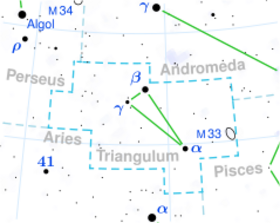Astronomy:15 Trianguli
| Observation data Epoch J2000.0 Equinox (celestial coordinates) | |
|---|---|
| Constellation | Triangulum |
| Right ascension | 02h 35m 46.821s[1] |
| Declination | +34° 41′ 15.18″[1] |
| Apparent magnitude (V) | 5.396[2] |
| Characteristics | |
| Evolutionary stage | AGB[3] |
| Spectral type | M3 III[2][4] |
| Variable type | suspected[5] |
| Astrometry | |
| Radial velocity (Rv) | −8.646±2.407[6] km/s |
| Proper motion (μ) | RA: 26.689±0.361[1] mas/yr Dec.: −48.894±0.233[1] mas/yr |
| Parallax (π) | 4.8075 ± 0.2721[1] mas |
| Distance | 680 ± 40 ly (210 ± 10 pc) |
| Details | |
| Mass | 1.689±0.084[2] M☉ |
| Radius | 118.453±5.923[2] R☉ |
| Luminosity | 1,668[7] L☉ |
| Surface gravity (log g) | 0.489[8] cgs |
| Temperature | 3,572[8] K |
| Metallicity [Fe/H] | 0.08[8] dex |
| Other designations | |
| Database references | |
| SIMBAD | data |
15 Trianguli is a suspected variable star located in the northern constellation Triangulum, with an apparent magnitude of 5.4[2] making it faintly visible to the naked eye under ideal conditions, although it is suspected of being an irregular variable with a range of 0.14 magnitudes.[5] The star is situated about 480 light years[1] away but is approaching with a heliocentric radial velocity of −8.646 km/s.[6]
15 Trianguli has a stellar classification of M3 III.[2][4] It has 1.7 times the mass of the Sun and 118 times the radius of the Sun.[2] It has an effective temperature of 3,572 K[8] and shines at 1,668 times the luminosity of the Sun[7] from its photosphere, giving it an orange glow. It is an asymptotic giant branch star, which means it is fusing hydrogen and helium in separate shells around an inert carbon core.[3]
References
- ↑ 1.0 1.1 1.2 1.3 1.4 1.5 Brown, A. G. A. (2021). "Gaia Early Data Release 3: Summary of the contents and survey properties". Astronomy & Astrophysics 649: A1. doi:10.1051/0004-6361/202039657. Bibcode: 2021A&A...649A...1G. Gaia EDR3 record for this source at VizieR.
- ↑ 2.0 2.1 2.2 2.3 2.4 2.5 2.6 Kervella, Pierre; Arenou, Frédéric; Mignard, François; Thévenin, Frédéric (March 2019). "Stellar and substellar companions of nearby stars from Gaia DR2 - Binarity from proper motion anomaly". A&A 623: 623. doi:10.1051/0004-6361/201834371. Bibcode: 2019A&A...623A..72K.
- ↑ 3.0 3.1 Eggen, Olin J. (1992). "Asymptotic Giant Branch Stars Near the Sun". The Astronomical Journal 104: 275. doi:10.1086/116239. Bibcode: 1992AJ....104..275E.
- ↑ 4.0 4.1 Cruzalèbes, P. et al. (2019). "A catalogue of stellar diameters and fluxes for mid-infrared interferometry". Monthly Notices of the Royal Astronomical Society 490 (3): 3158–3176. doi:10.1093/mnras/stz2803. Bibcode: 2019MNRAS.490.3158C.
- ↑ 5.0 5.1 Samus, N. N. et al. (2004). "VizieR Online Data Catalog: Combined General Catalogue of Variable Stars (Samus+ 2004)". VizieR On-line Data Catalog: II/250. Originally Published in: 2004yCat.2250....0S 2250. Bibcode: 2004yCat.2250....0S.
- ↑ 6.0 6.1 Brandt, Timothy D. (2021). "The Hipparcos-Gaia Catalog of Accelerations: Gaia EDR3 Edition". The Astrophysical Journal Supplement Series 254 (2): 42. doi:10.3847/1538-4365/abf93c. Bibcode: 2021ApJS..254...42B.
- ↑ 7.0 7.1 McDonald, I.; Zijlstra, A.A.; Boyer, M.L. (21 November 2012). "Fundamental parameters and infrared excesses of Tycho-Gaia stars". Monthly Notices of the Royal Astronomical Society 427 (1): 343–357. doi:10.1111/j.1365-2966.2012.21873.x. Bibcode: 2012MNRAS.427..343M.
- ↑ 8.0 8.1 8.2 8.3 Ghosh, Supriyo; Mondal, Soumen; Das, Ramkrishna; Khata, Dhrimadri (2019). "Spectral calibration of K-M giants from medium-resolution near-infrared HK-band spectra". Monthly Notices of the Royal Astronomical Society 484 (4): 4619–4634. doi:10.1093/mnras/stz299. Bibcode: 2019MNRAS.484.4619G.
 |


